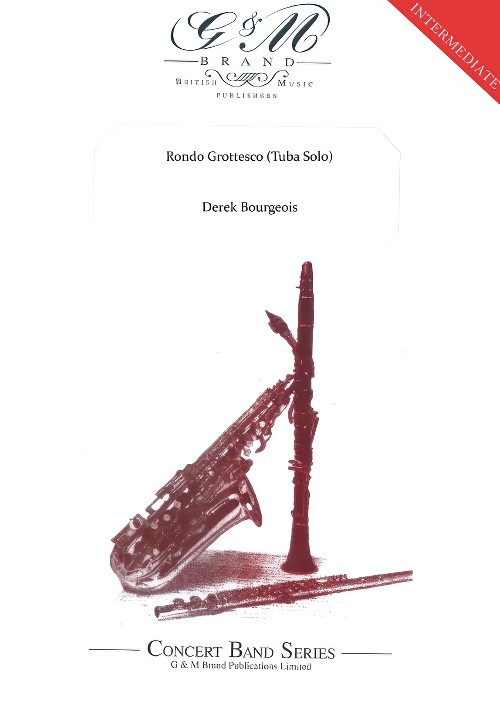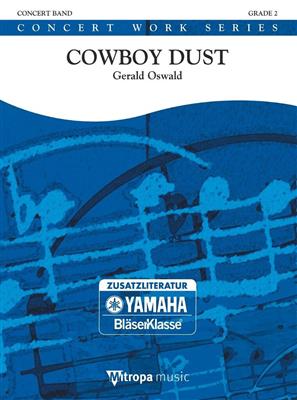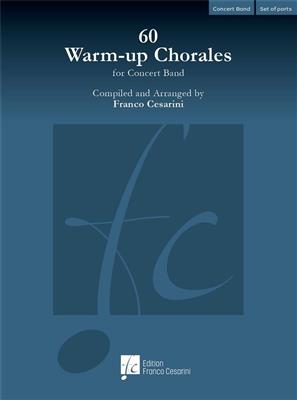Results
-
 £11.95
£11.95Rondo Grottesco (Tuba Solo) (Concert Band - Score Only) - Bourgeois, Derek
When Bourgeois, Derek was a schoolboy he played tuba, and as a budding composer he decided he needed a grand vehicle to display his mastery of the instrument. He therefore set out to write a work and completed the opening tune. At that time, however he did not have the expertise to develop the material and after the tune the concerto came to an abrupt end. Many years later the composer was invited to write a piece for tuba and concert band and Rondo Grottesco is the result - the schoolboy composers original tune developed not into a grand concerto but a fine miniature.
Estimated dispatch 7-14 working days
-
 £149.99
£149.99Marinarella Wind Band Set (Score & Parts)
Julius Fucik (1872-1916) was born in Prague, Czech Republic. He studied under Antonin Dvor?k and at a young age played in military bands and later became bandmaster, a profession he practiced in various cities with many bands. In 1913 he settled in Berlin where he started his own music publishing house. As a composer Fucik is known for his light entertaining music however he also wrote chamber music, songs, choral works, a mass, a requiem and an unfinished opera. Many of his works have fallen into oblivion but many of his marches such as Einzug der Gladiatoren, Regimentskinder and Florentiner Marsch are still often played. With the concert overture Marinarella, Fucik takes us to an imaginary seaside resort on a beautiful spring day. Marinarella, a girl of the sea, accompanies us on our stroll. Leisurely walking couples on the boulevard, the murmur of the sea, fragments of a waltz melody from a caf? and a concert band performing a promenade concert pass you by. A fantastic opening work for any concert. 0:11:30
Estimated dispatch 7-14 working days
-
 £159.99
£159.99Nostradamus (Concert Band - Score and Parts)
Nostradamus is probably the best-known prophet of the last 1000 years. He lived at the time of the Inquisition and his predictions and medical therapies as a physician caused him to face the wrath of the church forcing him to flee many times. Following the loss of his family to the plague he devoted himself to clairvoyancy. He predicted many events in history in coded form and although there are many ways to interpret these, many are believed to be accurate and Nostradamus is still considered to be a unique personality. Whether he is denounced as a charlatan or promoted as a myth he has surely moved humankind with his prophecies.Otto M. Schwarz, soundtrack composer since 2001, wrote a cinematographic work about this man, who is probably the best-known prohet of the last 1000 years. 12:30
Estimated dispatch 7-14 working days
-
 £137.99
£137.99Odyssee Wind Band Set (Score & Parts)
The Odyssee tells the story of Odysseus, the undaunted hero. In times long ago the blind poet Homer wrote this famous epic. The "Odyssey" follows the "Iliad", the story of the bloody war between the Greek and the Trojans. This battle ends after ten years thanks to the Odysseys famous trick. the Trojan Horse. The Odyssey is not a war epic, but a story about perseverance, loyalty, adventure, and the survival instinct of its ingenious hero. In The Odyssey, Homer describes how Odysseus, the king of Ithaca, had to endure another ten years of affliction after the ten years of war in Troy before he could finally return to his home land. During those years, his wife, Penelope, had to try and keep her many admirers away. These men not only wanted het hand but also the kingship. To prove her husbands worth, she played a trick: "As soon as I have finished weaving this shroud for my father-in-law, Laertes, I will choose one of you to become my husband", she promised them. But during the night, she secretly loosened what she had woven during the day, prolonging the time until Odysseus would finally return. After twenty long years, when he finally stood at the door, she wondered: Is this really my husband? Is he an imposter? Cunningly, she asked him to move the bed, because only she and her husband know that the bed was immovable and was build around an old three trunk! Odysseus was deeply moved: this really was his wife, his Penelope! Nearly three thousands years later, the loyalty and strength of this character, and all the dangerous adventures that Odysseus survived thanks to courage and intelligence, still moves us today. Odyssee by Jan Bosveld is not just an adventure story, but rather a characteristic piece in which memories of Homers story can be heard. The composition opens with a firm, stirring theme describing our hero, Odysseus, in detail: This man is not to be taken lightly. The further development of this short introduction completes this character sketch: trustworthy, perseverant, and a genius. After that we can picture Odysseus on the lonely beach of Ogygia. Do the trumpets depict his memories of the war of Troy? Does he think of his wife, as we recognise the weaving loom of Penelope in the murmuring eighth? In the solemn, plaintive part that follows, we can imagine Penelope feeling lonely, sitting in the womens room with her servants.One of the girls plays the harp, but that does not clear the sombre atmosphere. Then we can imagine seeing the sorceress Circe, who changed Odysseus men into swine. After she gives a simple magic sign something follows that reminds us of the sound of pigs grunting. Then the Odysseus theme resounds: the hero comes to savi his comrades. Assisted by Hermes, he forces Circe to lift the spell. The piece ends the same way as it began, with an animated theme: Odysseus is still the same, undefeated and not to be taken lighty! 07:45
Estimated dispatch 7-14 working days
-
 £149.40
£149.40Lamento - Jerker Johansson
Lamento was composed in memory of Bjarne Haug Thesen (1957-2023). Bjarne came from Nord-Odal and had his musical base in Mo Skolemusikk and Nord-Odal Hornmusikk. In 1987, he was elected vice-president of the Norwegian Band Ferderation (Norges Musikkorps Forbund - NMF), a position he held until 1990. He was an important contributor to the development of the organization and is remembered for his knowledge, bold thoughts and winning spirit. Bjarne had this gift of delivering stories that fit to the issues that were up for debate, and if things started to get a little heated, these inputs from Bjarne often ensured that the debate got back on track. He was on the editorial board for the book "Norske musikkorps" which was published in 1990, and was also involved in the 100th anniversary of the NMF in 2018. Lamento was premiered on the 13th of December 2023 by Oslo Postorkester conducted by Stina Widn.
Estimated dispatch 7-14 working days
-
 £228.70
£228.70The Music of Antonio Carlos Jobim - Antonio Carlos Jobim
ivind Westby has written a number of excellent but demanding instrumental arrangements for Concert Band. In the present one, he has transcribed five of the most famous by Antonio Carlos Jobim. Brazilian composer Antonio Carlos Jobim (1927-1994) grew up near Ipanema, the famous beach in Rio de Janeiro. His big break through and most creative period came in the 50's and 60's which gave him the status as the greatest Brazilian composer of all times. Together with Stan Getz and Jo�o and Astrud Gilberto he recorded one of the best selling jazz-albums of all times, an album which feature several of his most famous compositions. His inspiration includes another Brazilian great; Pixinguinha, but also classical composers like Frederick Chopin and Claude Debussy. He died in NYC in 1994 after composing approx. 400 works. He is recognized all over the world as one of the most influential composers of the 20th century.
Estimated dispatch 7-14 working days
-
 £47.50
£47.50Cowboy Dust - Gerald Oswald
In this work, the composer depicts an adventurous day in the life of a cowboy. As he rides his horse across the plains, clouds of 'cowboy dust' whirl up behind him. He rides over the prairie, faces dangerous snakes, gallops across dusty fields and stumbles upon an ambush of bandits. In the gunfight that follows, he is the victor, and he rides along the prairie a silent hero, on his way to another adventure.
Estimated dispatch 7-14 working days
-
 £168.50
£168.5060 Warm-up Chorales for Concert Band
During his experience as a band conductor and teacher of wind orchestra conducting at university, Franco Cesarini has dealt with the topic of warm-ups very frequently. Throughout these long years of conducting he has had the opportunity to try many existing methods, evaluating their advantages and disadvantages.After a long time, he has decided to compile a collection of chorales for warm-ups, which are organized according to the criteria that he considers most effective.While working on his60 Warm-up Chorales for Concert Band, Franco Cesarini has always borne in mind that amateur musicians play for pleasure.He feels that it is extremely important that they have satisfaction at every moment of the rehearsal and not to start the rehearsal with needless "punishing" exercises. Nobody is really motivated to start playing with scales, long notes, or tricky rhythmical exercises. There is often a distinguished absentee in band rehearsals, namely music itself!Although this publication does not foresee a specific tempo for the chorales, they should often be performed rather slowly but without dragging.Dynamics are not indicated, so that the conductor has the opportunity to draw the attention of the musicians to his gestures and to make them react according to his indications.Timpani and bell parts have been added with the aim of not leaving the percussionists completely inactive during the warm-up phase, but can also be omitted.The chorales are written in four parts (SATB) and are also playable in smaller groups. The four voices can be played in different combinations of woodwinds or brass quartets or in mixed combinations.The collection includes ten chorales for the following keys: D flat major, A flat major, E flat major, B flat major, F major and C major.With his 60 Warm-up Chorales Franco Cesarini would like to convey the message to play the chorales in a musical way, thus raising the musicians' awareness of phrasing, the right interpretation of cadences, rubato and agogic.Above all, never do anything without putting the musical aspect in the foreground. 60 Warm-up Chorales for Concert Band: A perfect collection to warm-up and improve tuning of a concert band!
Estimated dispatch 7-14 working days
-
 £79.99
£79.99Commemoration - James Barnes
Commemoration was commissioned by the members of the Northwest North Carolina Bandmasters Association to recognize the distinguished career of Dr. William A. Gora, the longtime Director of Bands at Appalachian State University, who passed away in 2015. Bill was loved by his students, respected by his peers and cherised by his many friends. A brilliant musician, a fine conductor and a warm human being with a marvelous sense of humor, Bill has been sorely missed by all. Gora was friends with composer James Barnes for over 40 years. They met when Barnes was still in graduate school at Kansas and Gora had just finished his DMA at the University of Florida. When the NNCBDA asked Barnes to compose a work in Bill's honor, he was honored to do so. He decided to write a cheerful work for Bill, full of energy, color and melody, because he knew this is what he would have wanted; no funeral dirges for Bill Gora. The soft middle portion of the work, a hymn-like tune scored in saxophone choir, was included because Bill was a fine saxophonist and, for many years, the saxophone teacher at ASU.
Estimated dispatch 7-14 working days
-
 £101.30
£101.30Gambetta-Marsch - Oscar Borg
Alfred Oscar Johannesen Borg (1851-1930) was a Norwegian composer, conductor and musician.He is best known for his compositions for concert band and especially marches.For many years, he conducted the Military Band in is hometown ofFredrikshald (today named Halden) and many of his marches are composed when he was conductor of this band.The march Gambetta has got it's name after the French politician Lon Gambetta (1838-1882) which was a republican statesman who helpeddirect the defense of France during the Franco-German War of 1870 71. He made essential contributions to found the Third Republic in France in 1871.
Estimated dispatch 7-14 working days
